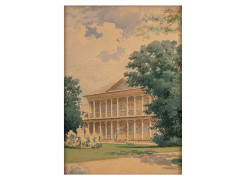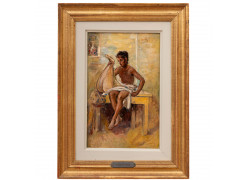Additional info:
Theodor Aman occupies a foundational place in nineteenth-century Romanian art, widely regarded as the initiator of institutional frameworks and academic practices that aligned local artistic production with Western European standards. Trained initially under Constantin Lecca and Carol Wallenstein de Várally in Craiova and Bucharest, he continued his studies in Paris with Michel-Martin Drolling and François-Édouard Picot, acquiring an academic formation enriched by Romantic influences. His debut at the Paris Salon in the early 1850s, with compositions such as the Self-Portrait and The Battle of Oltenița, signalled both an engagement with contemporary events and an entry into the European art market, where the distribution of prints through the Goupil network ensured broader visibility. Upon his return to Bucharest, Aman combined artistic production with institutional innovation. He was instrumental in establishing the School of Fine Arts, precursor of today’s National University of Arts, and in organizing the 1865 Exhibition of Living Artists, a local counterpart of the Paris Salon. His activity as painter, engraver, and teacher reveals a sustained ambition to systematise Romanian artistic life and to establish structures of recognition comparable with those of Western Europe. The range of his work demonstrates versatility in subject matter and technique. His historical compositions, often linked to national narratives, coexisted with genre scenes, portraits, still lifes and Orientalist motifs. Within genre painting, Aman shifted between anecdotal depictions and socially descriptive registers. Some works display sharp observational detail, while others reflect the conventions of bourgeois taste. Portraits and interiors, meticulously rendered in costume and décor, underscore the artist’s sensitivity to social types and provide valuable documentation of contemporary life. His treatment of rural themes, at times idealised, mirrors both the broader European vogue for rustic themes and while engaging with debates surrounding the “peasant question” in nineteenth-century Romania. Despite his academic discipline and preference for compositional clarity, Aman’s oeuvre contains moments of stylistic curiosity, from an awareness of plein-air practice to later explorations of freer brushwork. Yet his lasting legacy rests less in stylistic innovation than in the consolidation of a professional artistic culture. The museum established in 1908 in his former Bucharest residence preserves a significant body of his works, bearing witness to his dual role as artist and cultural organizer. Aman’s position within Romanian art history is therefore complex. While his painting did not engender a direct school of followers, his institutional authority, pedagogical influence, and eclectic output laid the groundwork for the subsequent development of Romanian modern painting. For collectors and scholars, his works remain not only objects of aesthetic merit but also documents of a formative moment in the construction of a national artistic identity.
-
Dado Djuric
Cetinje, Montenegro, 1933 - Pontoise, France, 2010 -
Arthur Verona
Brăila, Romania, 1867 - Bucharest, Romania, 1946 -
Victor Man
b. Cluj-Napoca, Romania, 1974 -
François Pamfil
Sibiu, Romania, 1940 - Bucharest, Romania, 2012 -
Florina Drăguș
b. Ploiești, Romania, 1991

